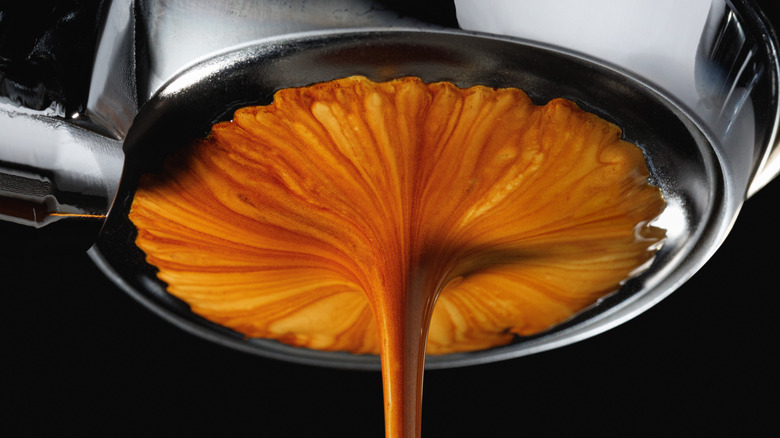The Main Difference Between Long Pull And Short Pull Espresso
You know the difference between espresso and black coffee, but have you noticed any variations among espresso shots? Not all espresso shots are created equal; so much, in fact, chemist Chris Hendon — who has won titles for his espresso-pouring expertise — has studied what constitutes the perfect espresso pull (via Wired). His research, titled "The effect of bean origin and temperature on grinding roasted coffee," notes that temperature impacts the way in which coffee beans are ground, and his work has held implications for baristas looking to maximize both rich and subtle flavors found in coffee beans.
According to the Smithsonian Magazine, the first variation of an espresso machine was developed in Italy in the late 1800s. Luigi Bezzerra's improvements helped the single-shot espresso gain steam and reputation as coffee could be brewed in seconds. Fellow Italian Desiderio Pavoni added a pressure release valve and steam wand to bring "cafe espresso" to the 1906 Milan Fair. Since then, baristas around the world have deliberated over specifics of how to perfect and pull the most satisfying espresso.
Skimming articles and online tutorials could lead any aspiring coffee maker to think pulling an espresso is a science or different language entirely. In a NY Times Wirecutter article, the specifics of pulling an espresso shot are detailed, with precise measurements for shot times and ratios of brew to water. Does it matter how long espresso grind is exposed to water? What is a long and short espresso shot, anyway?
Different volumes mean different tastes
If you're not a professional barista, you may not be able to identify different coffee drinks, much less spot any variations between espresso pulls. A short shot, called ristretto, Italian for "restricted," is a concentrated, flavor-filled pull that uses less hot water than traditional espresso (via Starbucks). It's quick and fast and results in a smaller, sweeter serving of coffee. When coffee grinds are exposed to longer durations of water and steam, the taste of coffee beans can turn bitter. This sometimes occurs with a lungo, the Italian description for a longer, more voluminous espresso shot (per Serious Eats). Not to be confused with an Americano, an espresso topped with hot water, a lungo is simply made by a longer pull.
Depending on the coffee beans used, espresso pulls can bring out subtle notes and terroir in the coffee, from bitter to smooth flavors that develop when exposed to varying degrees of water and heat. If you're thinking about caffeine intake, there's more to be found in the lungo, as the amount of caffeine is proportional to the amount of water (via Cafe Vergnano). But if you're thinking about taste, it's worth experimenting with the beans and brews you have before making any final decisions about preferred choice of espresso.

